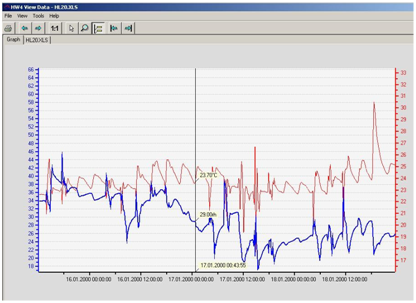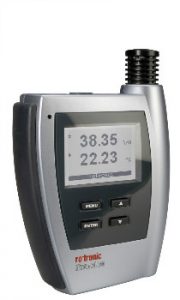Temperature and Humidity Meters
Mapping in General
Temperature and humidity levels that are out of specifications can cause damage ton production material and even ton the final product. You can imagine that this is very important for pharmaceutical companies. The public regulatory organizations require food and drug products to be stored and/or produced under appropriate conditions. Temperature and humidity are very important factors in order for the material to retain its identity, strength, quality, and purity.
The best way to check a room for humidity and temperature variations is to carry out a mapping. A mapping is consisting of placing dataloggers in various strategic locations in a room and monitoring the different parameters accurately. Depending on the room topology, hot & cold spots may be present. Mapping gives a detailed image of the overall room homogeneity over a certain period of time for temperature and/or humidity. Based on the mapping data, the final monitoring systems can be installed.
How to Perform Mapping
 Depending on the size of the room and the internal and external influences the strategic mapping points are chosen.
Depending on the size of the room and the internal and external influences the strategic mapping points are chosen.
Small rooms: For chambers or rooms with dimensions of (LWH) 5 x 2 x 5m or smaller a minimal amount of 9 points are required. One at each corner and one point in the middle center point are mapped.
Large rooms: For rack warehouses, the sensors need to be placed according to a diagram or grid. Each horizontal shelf should have a mapping point. Depending on the width and depth of the shelf a sensor should be placed every 10 to 15 meters.
To determine the point on the vertical level, the lowest and the top shelf position is determininge the range in height. For shelving higher than 10m, sensors should be placed with a vertical spacing of approximately 4..6m.
In addition to the structured mapping points, the internal and external influences such as windows, loading docks, doors, or ventilation outlets need to be recorded.
A datalogger should also be placed outside the chamber to monitor the exterior climate. The seasonal climate does have a direct effect on the HVAC systems and therefore to the internal temperature and humidity. Because of that, mapping during the different seasons should be taken into account.
Commonly a logging interval of 10 minutes has proven to give enough resolution to analyze the data.
Before mounting your loggers make sure the devices are acclimatized for at least 2 hours.
A mapping session should be executed for a minimum of 2 weeks and under normal operating conditions.
Data Interpretation:
After performing a mapping, the data from the logger needs to be downloaded, analyzed, and documented.
Data Analyzing:
The ROTRONIC HW4 software offers various features for displaying, analyzing, and reporting the collected data.
HW4 diagram of the mapped points
The graph is the optimal tool to analyze the measured data. It displays the values from the beginning until the end of the recorded time. The HW4 Software allows for overlaying multiple probes on one graph and if needed psychometric values can be added. A zoom function is also available, so that selections can be enlarged and analyzed.
Log files
The ROTRONIC data logger offers the possibility to save data either as a protected logfile type (*.log) or as an open file type for excel (*.xls).
Statistical functions
This function calculates in one click, statistical figures:

Total mapping points, minimum, maximum average, standard deviation and Mean Kinetic Temperature (MKT).
The MKT is a calculated fixed temperature that gives simulation effects of temperature variations over a certain time period. It expresses the cumulative thermal stress experienced with a product at changing temperatures during distribution and storage.
Mapping Diagram:
The ROTRONIC HW4 software offers the possibility of a visual layout showing you exactly where the probes are placed in the room.

Final Report:
A final report contains all the above-mentioned data (data analyzing & mapping diagram) including a valid sensor certificate.
Recommendations:
Final reports must contain recommendations if any undesirable temperature and humidity patterns are seen. Such as: – Removing products from problem areas (such as hot spots) – changing work practices (such as keeping the door open or closed) – changing the location of heat generating devices—improving ventilation – adding air conditioning – adding humidifying / dehumidifying units.
Such changes can be considered to improve the homogeneity of the room climate.
Conclusion:
Mapping can be an extremely powerful tool to fulfill the regulatory requirements and can also reduce costs if the recommended improvements determined by the mapping process are implemented. The key is to carefully analyze the room space to ensure the proper placement of data loggers. Always use loggers that have been recently calibrated for recorded data and always document the position of each logger by serial number. Finally make the necessary changes to continuously improve warehouse conditions.
What solution can Rotronic offer?
ROTRONIC dataloggers offer several key features to make your mapping a successful one:
ROTRONIC offers for all products a calibration certificate the is traceable to the indicated references and working standards.
All ROTRONIC dataloggers have variable logging intervals, extraordinary long-term stability and a large data memory capacity.
ROTRONIC also offers a wide range of networking possibilities such as RS485, USB, LAN & WLAN. Probe extension cables up to 100m are also available and allow measurements to remote places of the room.
The validated HW4 software makes it easy to analyze the data or export the data into Excel for reporting and further processing as required by FDA 21 CFR Part 11.
- HL-21D ±0.2 °C FDA 21 CFR Part 11 / GAMP 4 compliant; Adjustable log interval Memory: 20000 data records
- HL-20D 0..100%rh, ±0.8 %rh / ±0.2 °C; FDA 21 CFR Part 11 / GAMP 4 compliant; Adjustable log interval Memory: 20000 data records
- HL-NT & docking station 47,000 data records /MB; 1..7 interchangeable probes; Various analog outputs; buzzer and LED indication; All psychrometic calculations FDA 21 CFR Part 11 / GAMP 4 compliant; Display…
- HC2-S -50…100°C, 0…100%rh, Ø15mm, ±0.8%rh and ±0.1K…
- Probe Extension Cables Various options e.g.: Passive Cable: 1,2 or 5m; Active Cable: 10..100m; Cable w. open ends for third party integrations
Customer Benefits:
Rotronic Loggers:
The long-term recording of humidity and temperature conditions is very important in storage, shipping, production processes. Once logged, the temperature and humidity data can be analyzed statistically and provide valuable information that can have an influence on people, materials and objects.
The ROTRONIC data loggers the requirements of GAMP 4 and FDA 21 CFR Part 11. They have a degree of functionality currently not achieved by any other logger while being easy to use and highly accurate.
The HL-21D & HL-20D Data loggers:
The battery-powered data logger is designed to be placed at any locations where cabling or external power supply is not available.
The HL-NT logger with Docking station:
Offers the widest range of possibilities. All loggers can directly be linked with the ROTRONIC HW4 software over LAN, WLAN, USB or RS485. Each logger is capable of handling up to seven probes when paired with the connected docking station.
The interchangeable HC2-S/ HC2-x probe systems make it easy to maintain each measurement point. Because of the AirChip3000 technology, all necessary calibration data is stored on the HC2 probe. The HC2 is even able to simulate values or detect sensor failure & can compensate for drift.
Source: Rotronic

